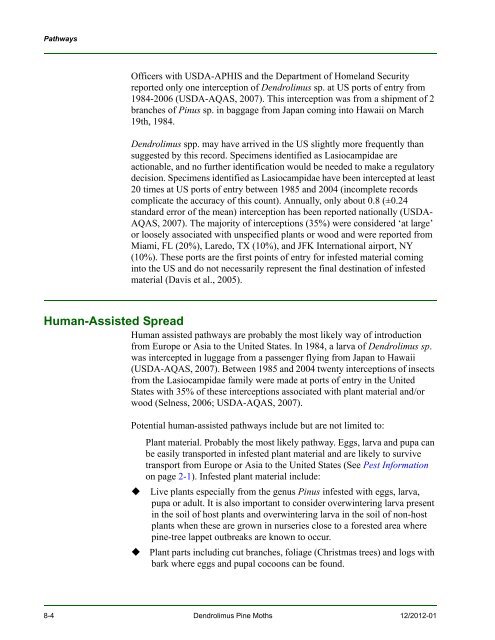New Pest Response Guidelines - aphis - US Department of Agriculture
New Pest Response Guidelines - aphis - US Department of Agriculture
New Pest Response Guidelines - aphis - US Department of Agriculture
Create successful ePaper yourself
Turn your PDF publications into a flip-book with our unique Google optimized e-Paper software.
Pathways<br />
Officers with <strong>US</strong>DA-APHIS and the <strong>Department</strong> <strong>of</strong> Homeland Security<br />
reported only one interception <strong>of</strong> Dendrolimus sp. at <strong>US</strong> ports <strong>of</strong> entry from<br />
1984-2006 (<strong>US</strong>DA-AQAS, 2007). This interception was from a shipment <strong>of</strong> 2<br />
branches <strong>of</strong> Pinus sp. in baggage from Japan coming into Hawaii on March<br />
19th, 1984.<br />
Dendrolimus spp. may have arrived in the <strong>US</strong> slightly more frequently than<br />
suggested by this record. Specimens identified as Lasiocampidae are<br />
actionable, and no further identification would be needed to make a regulatory<br />
decision. Specimens identified as Lasiocampidae have been intercepted at least<br />
20 times at <strong>US</strong> ports <strong>of</strong> entry between 1985 and 2004 (incomplete records<br />
complicate the accuracy <strong>of</strong> this count). Annually, only about 0.8 (±0.24<br />
standard error <strong>of</strong> the mean) interception has been reported nationally (<strong>US</strong>DA-<br />
AQAS, 2007). The majority <strong>of</strong> interceptions (35%) were considered ‘at large’<br />
or loosely associated with unspecified plants or wood and were reported from<br />
Miami, FL (20%), Laredo, TX (10%), and JFK International airport, NY<br />
(10%). These ports are the first points <strong>of</strong> entry for infested material coming<br />
into the <strong>US</strong> and do not necessarily represent the final destination <strong>of</strong> infested<br />
material (Davis et al., 2005).<br />
Human-Assisted Spread<br />
Human assisted pathways are probably the most likely way <strong>of</strong> introduction<br />
from Europe or Asia to the United States. In 1984, a larva <strong>of</strong> Dendrolimus sp.<br />
was intercepted in luggage from a passenger flying from Japan to Hawaii<br />
(<strong>US</strong>DA-AQAS, 2007). Between 1985 and 2004 twenty interceptions <strong>of</strong> insects<br />
from the Lasiocampidae family were made at ports <strong>of</strong> entry in the United<br />
States with 35% <strong>of</strong> these interceptions associated with plant material and/or<br />
wood (Selness, 2006; <strong>US</strong>DA-AQAS, 2007).<br />
Potential human-assisted pathways include but are not limited to:<br />
Plant material. Probably the most likely pathway. Eggs, larva and pupa can<br />
be easily transported in infested plant material and are likely to survive<br />
transport from Europe or Asia to the United States (See <strong>Pest</strong> Information<br />
on page 2-1). Infested plant material include:<br />
Live plants especially from the genus Pinus infested with eggs, larva,<br />
pupa or adult. It is also important to consider overwintering larva present<br />
in the soil <strong>of</strong> host plants and overwintering larva in the soil <strong>of</strong> non-host<br />
plants when these are grown in nurseries close to a forested area where<br />
pine-tree lappet outbreaks are known to occur.<br />
Plant parts including cut branches, foliage (Christmas trees) and logs with<br />
bark where eggs and pupal cocoons can be found.<br />
8-4 Dendrolimus Pine Moths 12/2012-01

















